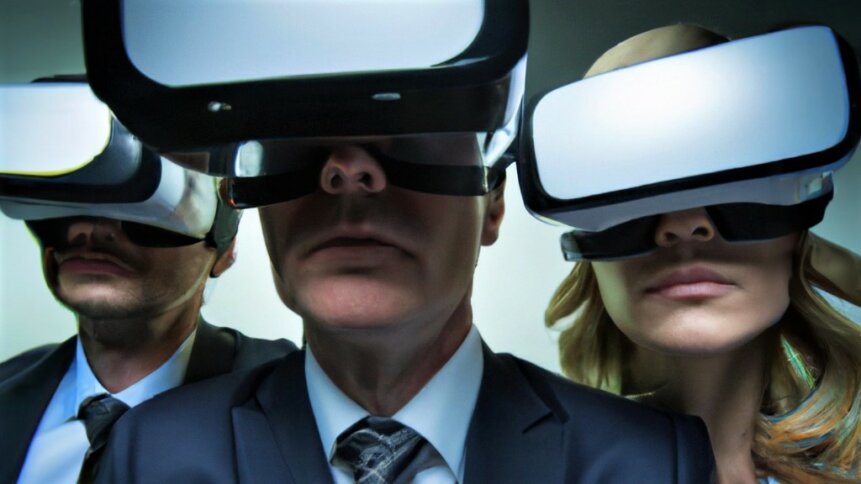Why 2024 could be a breakthrough year for enterprise VR

|
Getting your Trinity Audio player ready...
|
Some industry watchers may see VR as a solution in search of a problem. For example, take Mark Zuckerberg’s multibillion-dollar quest to bring the metaverse into the mainstream – a pursuit that’s left a puzzled look on Meta’s shareholders. But check again, and you’ll see that the Facebook founder could be making a surer bet than analysts first thought. And it’s not just about consumer gaming and social media; the list of enterprise VR applications is growing and on solid ground.
Apple is on track to launch its Vision Pro mixed reality device in 2024. And it’d be short-sighted to think that the hardware will do anything but add to the interest of developers keen to explore enterprise VR applications. However, the race for higher-performance processors and displays, capable of meeting the challenges of rendering believable visuals in the virtual world could be overplayed.
Trying enterprise VR for the first time
This author has recently sampled enterprise VR software running on Meta’s Quest 2 headset, and the hardware ran fine. In fact, the performance threshold may have already been crossed with the arrival of VR headsets, such as the Quest 2, which are standalone. Users don’t need to plug the head-worn devices into a computer, set up external tracking cameras, or even tether to a battery pack.
As soon as VR headsets became self-contained, the game changed, and developers know this. Speaking with Gemba CEO and co-founder Nathan Robinson and colleagues, TechHQ had the opportunity to find out what the challenges of developing enterprise VR applications really are. And it was interesting to note that the only hardware constraint that cropped up in the conversation was battery life.
No doubt, device makers and component suppliers will make improvements so that enterprise VR applications can run for longer between charges. And it shows that, arguably, having simpler hardware that doesn’t consume as much power as high-end devices such as Apple’s upcoming Vision Pro could be a blessing.
Meta has already teased VR fans with news of its Quest 3 device, which the firm plans to launch later this year. The metaverse champion has its Meta Connect event taking place next week on the 27th of September. And the company has said that it will have ‘lots more to share’ about the device on that date.
📣 Meta Quest 3. Meta Connect. Sept 27. 📣 https://t.co/Zbh3ck2Tl3#MetaQuest3 #MetaConnect2023 pic.twitter.com/giOZElkKNf
— Meta Quest (@MetaQuestVR) August 1, 2023
Like Apple with its Vision Pro announcement, Meta is pushing the benefits of the technology upgrades. But enterprise VR users of applications such as Gemba’s masterclass training platform will know that the experience is already a beneficial one. It genuinely feels like you’re interacting with attendees in the same room when, in reality, people could be miles apart and participating from different countries.
This rich and memorable VR experience is being produced using hardware that’s been available off-the-shelf for some time. And for those on a budget, Meta’s latest VR device launch might be even better news. The Quest 3 is priced starting at US $499, which is well below how much it’ll cost to buy Apple’s Vision Pro when it arrives in 2024.
However, we’ve already pointed out that developers don’t necessarily need the latest tech to deliver great enterprise VR experiences for users. And Meta’s Quest 3 launch will likely make Quest 2 machinery even cheaper and more available as people upgrade and sell their old devices.
Software update to improve CPU and GPU performance
Also, Meta revealed that – thanks to an upcoming software update – the Quest 2 is getting a 26% performance update to its CPU and a 19% speed increase to its GPU. If the Quest 2 was just fine already, those tweaks will only improve things and make the unit an even more compelling choice for enterprise VR.
That’s not to say that all companies have to do is buy an affordable headset and push software to the device. The challenge really comes with understanding how to navigate the virtual world and determine what design features work well and which ones don’t. And that is far from easy.
For example, returning to the conversation that TechHQ had with Nathan Robinson, Gemba’s co-founder and CEO pointed out that during the development of their enterprise VR platform, the team decided to do away with having legs on avatars.
A common assumption when designing VR apps is to think that users want realism, and in some cases they do. But it turned out that having legs on avatars didn’t hit the right note. People may think that they walk beautifully in the real world, but often, there’s a big difference between their perception of the motion and how it appears to others.
And when you can see how you actually walk, by tracking the position of legs and feet, the result was a distraction to masterclass attendees in the virtual world. But if you remove those digital legs and have avatars float gracefully through their surroundings – problem solved.
It’s lessons like these that allow VR software developers to progress and create great user experiences. Tech is an enabler, for sure, and low-latency performance is essential to avoid users becoming nauseous as they accelerate and brake their way around virtual driving environments, and navigate other dynamic, high-speed situations.
However, perhaps one of the strongest learnings so far is that the design language of enterprise VR and other commercial augmented and mixed reality apps may not be what you think it is. Naturally, best practices will emerge as more developers join the ecosystem, and – just like with designing mobile apps – the most appealing solutions will rise to the top of the download charts.









